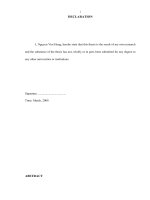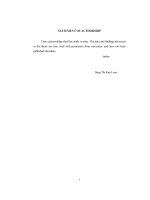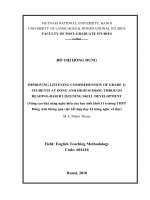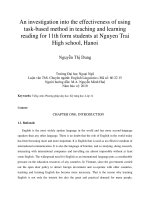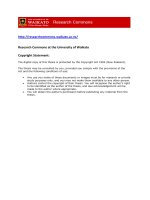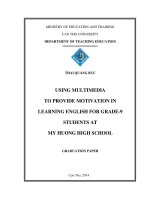IMPROVING STUDENTS’ SPEAKING SKILL THROUGH TASK BASED LEARNING a CASE STUDY OF 10THGRADE STUDENTS AT TAY HIEU HIGH SCHOOL
Bạn đang xem bản rút gọn của tài liệu. Xem và tải ngay bản đầy đủ của tài liệu tại đây (400.83 KB, 94 trang )
1
MINISTRY OF EDUCATION AND TRAINING
VINH UNIVERSITY
NGUYEN THI LIEU
IMPROVING STUDENTS’ SPEAKING SKILL
THROUGH TASK- BASED LEARNING : A CASE STUDY
OF
10THGRADE STUDENTS AT TAY HIEU HIGH SCHOOL
Major: Theory and Methods of English Language Teaching
Code: 60.14.01.11
MASTER’S THESIS IN EDUCATION
Supervisor: Tran Ba Tien, Ph.D.
2
Nghệ An, 8/2017
i
STATEMENT OF AUTHORSHIP
I hereby acknowledge that this study is my own work. The data and
findings discussed in the thesis are true, used with permission, and have not
been published elsewhere.
Author
Nguyen Thi Lieu
ii
ABSTRACT
This study deals with the fundamental learning activities for improving
learners’speaking skill as they are applied by students in the contexts of taskbased activities. The activities are interacted with students with the help of the
task based learning (TBL) as an educational tool to create an meaningful class to
meet the need of students’ motivation and learning styles for their participation
in speaking the target language. Based on the theoretical and practical findings,
some kinds of task based activities and their use in teaching students’ speaking
skill would be also introduced. To achieve the above aims, in this study the
action research method is employed with forty students’ class taught by TBL
approach.
The findings of the study indicated that TBL is an effective approach for
developing students’ speaking skill. The participants showed great interest
towards TBL which helped to increase students’ comfort level and selfconfidence when dealing with the English speaking target. Task-based learning
is really encouraging for students mainly because the tasks are real, interactive
and require them to work in groups, which they prefer especially the tasks they
often apply mimically their real-life. Furthermore, the results of the analyses of
the survey questions confirmed that learners had positive attitude towards TBL,
as they provided the students often with a lot of interactive activities which
created an environment that was fun, enjoyable and effective for improving the
students’ speaking skill.
iii
ACKNOWLEDGEMENTS
This thesis would not have been possible without the support of many
people.
First, and foremost, I would like to express my sincere gratitude and
deepest appreciation to Dr. Tran Ba Tien, the supervisor of this thesis for his
advice, support and encouragement, especially for the permission to try out this
experimental study in the Teaching English as a Foreign Language at Tay Hieu
high school. This research would not be possible without him, and this success
would not have been achieved.
This is also a chance for me to express my warmest thanks to my teachers
at the Department of Foreign Languages, Vinh University, Nghe An, for their
useful knowledge conveyed via interesting lectures.
My heartfelt thanks to my colleagues, friends, especially my beloved
family. They understand and encourage me during my studies at Tay Hieu high
school. I feel greatly indebted to them for their essential help and
encouragement.
iv
TABLE OF CONTENTS
Page
STATEMENT OF AUTHORSHIP.........................................................................i
ABSTRACT..........................................................................................................ii
TABLE OF CONTENTS.....................................................................................iv
Page.....................................................................................................................iv
TABLE OF TABLES.............................................................................................v
TABLE OF FIGURES...........................................................................................v
Chapter 1. INTRODUCTION...............................................................................1
v
TABLE OF TABLES
Table 4. 1. Students encounter problems about TBLT (n= 40)Error: Reference
source not found
Table 4.2. Students’ perception about TBLT (n=50)....Error: Reference source
not found
Table 4.3. Students’ ideas about effectiveness of TBL Error: Reference source
not found
TABLE OF FIGURES
Figure 4.1. Students encounter problems about TBLT Error: Reference source
not found
Figure 4.2. Students’ perception about TBLT........Error: Reference source not
found
Figure 4.3. Students’ ideas about effectiveness of TBLError: Reference source
not found
1
Chapter 1. INTRODUCTION
1. Rationale
Nowadays English becomes more and more important in the daily lives of
the Vietnamese people for many years due to its influence on education, careers
and economics. Therefore, developing speaking skills in English for learners to
communicate with foreigners confidently is necessary in this modern stage,
along with understanding differences in culture and holding positive attitudes
towards using English ( Genc & Bada, 2005). Bailey and Savage (1994) state
that to communicate on a daily basic skill that also helps an English learner
become a good reader and writer spontaneously. Moreover, Ellis (2003) states
that the main purpose of a learner studying English as a Second Language (ESL)
is to reach a personal goal to achieve success.
The Ministry of Education of Vietnam is focusing on new standards for
English in school curriculum design. The new standards are absolutely flexible,
and offer teachers opportunities to determine the suitable methodology to be
used. They added that the aim of the new curriculum is to raise four domains of
language learning like access to information, social interactions, in obtaining
and presenting information, and in developing appreciation of the English
language and its literature.
In recent times, when speaking about teaching and learning English,
Deputy Prime Minister and Minister of Education and Training Nguyen Thien
Nhan showed a quite challenging vision: How to turn the capacity of English
use of Vietnamese people in the next 10 to 15 years become a strength.
Responding to global challenges, English has been placed in the curriculum
from primary to advanced levels. According to the draft Development Strategy
2008-2020, English will be a compulsory elementary course (from grade 3) in
the Vietnam education system. Problems in teaching and learning English as a
2
foreign Foreign language (TEFL) are the concerns of not only teachers but also
learners. This problem is partly affected by teaching methods, i.e. many
Vietnamese instructors teach English by lecturing and focusing on grammatical
rules instead of language use. They often provide insufficient opportunities for
learners to practice English. Making the situation worse, not only teachers but
also learners frequently use Vietnamese throughout English classes. Another
obstacle to EFL learners is that Vietnamese teachers mainly make use of the
traditional teacher- centered approach in which teachers control learning and
teaching process. According to Ruso (2007), students do not like teachers who
spend most of the class time lecturing. Lecturing time make learners less eager
to work because they do not like being passive in classroom. As a result, the
students have limited input to learning process. Learners encounter more other
difficulties in learning English. Many EFL learners cannot effectively use
English in conversation. Although many of them have learned English for ten
years, they still cannot practice it in real life situations. They tend to avoid using
target language and cannot apply it in genuine communication. Hashim (2006)
shows that learning a language flourishes most when learners are in positive
environment and are given chances to communicate in authentic situations.
Effectively, it has been suggested that teachers abandon the traditional teaching
approach and change it into communicative language teaching (CLT) (Lochana
and Deb, 2006).
A field of CLT is task- based learning. This is a practical approach to the
learning process, using different tasks and challenges for learners to think freely
and develop their competence. Task- based learning offers diverse advantages by
helping learners develop cognitive processes, creative thinking and problemsolving skills. Many learners say that when performing a variety of tasks, they
have opportunities to use language communicatively. They also state that it is
3
enjoyable doing tasks within in group, and this help them learn language
( Lochana and Deb, 2006).
Research demonstrates that task- based learning has been considered as an
alternative methodology to solve the crisis of teaching English. Oxford (2006)
states that task-based learning and teaching is an exciting field which provides
enormous riches if explored by teachers in their dual roles as instructors and
action researchers. In addition, Muller (2006) holds that after using task- based
learning, teachers can be confident that they are meeting institutional
requirement and facilitating the development of genuine communication skills
among students. The task based language teaching approach views the learning
process as a set of communicative tasks that are directly linked with the
curricular goals and purposes. This is a good approach because provides learners
real practice with the target language but we think it is impossible to learn
applying only this approach.
Task- based learning provides many advantages in teaching English as a
Foreign Language (TEFL) because it offers language experience in the
classroom. Task- based learning places the students in real world situation, so
the learning skills can be applicable to real situations. In addition, Task- based
learning implies that an oral communication is essential for doing a specific
task. The learners are also exposed to as much of the foreign language as
possible in the order to merely observe it. Willis (1998) holds that the taskbased learning framework, combined with tasks and texts provides learners rich
exposures to language more opportunities to use it themselves. Throughout the
task cycle, emphasis is on learners’ understanding and expressing meaning to
complete tasks.
4
This approach to teaching communicative English has been popular for
over the past few years. This is the reason for my decision to conduct the
research on improving students’ speaking skills through Task- based learning.
2. Aims and objectives
The study aims to help students improve their English speaking skill
through Task-based activities. It attempts to investigate the problems that the
students often have when doing task based activities. It also looks into students’
perception of TBL and finds out measures to help students to improve their
speaking competences.
3. Scope of the study
The research only focuses on teaching common tasks used in speaking
teaching and their benefits to 10th graders at a mountainous high school in Nghe
An. From the findings of the research, adapted tasks will be given to improve
effectively the students’ English speaking. In this study the action research
method is employed with the treatment of an experimental group of 40 students
in class 10 H taught by using the TBL approach.In fact, these students groups
have the same level of English background. They will learn four speaking
lessons in the second term in the School Year 2016- 2017 at Tay Hieu high
school.
4. Methods of the research
The study employs the experimental research method. In order to achieve
the research goals, it attempts to answer the following questions:
1.
What
are
problems that the
students
often
encounter
when performing Task-based activities?
2. What is the students’ perception of learning the speaking skill through
Task-based learning?
5
3. Does Task-based learning help students improve their speaking skill ?
If so, to what extent?
5. Organization of the thesis
The study will consist of the following parts:
Chapter 1- Introduction- provides rational, the aims and objectives, scope
of the study and methods of the research.
Chapter 2- Literature review- presents the previous study related to the
thesis and some concepts as theoretical basic for the study.
Chapter 3- Methodology- describes research setting, a brief introduction
of participants, research instruments, research questions and procedure of the
research.
Chapter 4 - Findings and Discussion- presents the results and discussions
developed after the linguistics figures and explained.
Chapter 5- Conclusion– summarizes the main findings touched upon in
the research, limitations of the research and some suggestions for further studies.
Following the chapters are the references and appendices.
6
Chapter 2. LITERATURE REVIEW
2.1. A historical review ofteaching methods
2.1.1. Grammar Translation Method (GTM)
GTM is sometimes also known as the Classical Method, which is a
traditional teaching technique that was used to teach Latin and Greek and was
particularly in vogue during the 16 th century.The focus at this time was on the
translation of texts, grammar, and rote learning of vocabulary. There was no
emphasis on speaking and listening comprehension because Latin and Greek
were taught more as academic subjects rather than a means of oral
communication.
GTM tended to be referred to in the past tense as if it no longer existed
and had died out to be replaced world- wide by the fun and motivation of the
communicative classroom. If we examine the principal features of Grammar
Translation, however, we will see that not only has it not disappeared but that
many of its characteristics have been central to language teaching throughout the
ages and are still valid today. The Grammar Translation method embraces a wide
range of approaches but, broadly speaking, foreign language study is seen as a
mental discipline, the goal of which may be to read literature in its original form
or simply to be a form of intellectual development. The basic approach is to
analyze and study the grammatical rules of the language, usually in an order
roughly matching the traditional order of the grammar of Latin, and then to
practise manipulating grammatical structures through the means of translation
both into and from the mother tongue. The method is very much based on the
written word and texts are widely in evidence. A typical approach would be to
present the rules of a particular item of grammar, illustrate its use by including
the item several times in a text, and practise using the item through writing
sentences and translating it into the mother tongue. The text is often
7
accompanied by a vocabulary list consisting of new lexical items used in the text
together with the mother tongue translation. Accurate use of language items is
central to this approach. Generally speaking, the medium of instruction is the
mother tongue, which is used to explain conceptual problems and to discuss the
use of a particular grammatical structure.
It all sounds rather dull but it can be argued that the Grammar Translation
method has over the years had a remarkable success. Millions of people have
successfully learnt foreign languages to a high degree of proficiency and, in
numerous cases, without any contact what so ever with native speakers of the
language. There are certain types of learners who respond very positively to a
grammatical syllabus as it can give them both a set of clear objectives and a
clear sense of achievement. Other learners need the security of the mother
tongue and the opportunity to relate grammatical structures to mother tongue
equivalents. Above all, this type of approach can give learners a basic
foundation upon which they can then build their communicative skills. GTM can
also be boring for many learners, but if it is combined with the more enlightened
principles of the Communicative Approach may well be a suitable combination
for many learners. On the one hand, they have motivating communicative
activities that help to promote their fluency and, on the other, they gradually
acquire a sound and accurate basis in the grammar of the language. Although
considered outdated, this teaching method is still common in many countries and
institutions around the world, and still appeals to those interested in languages
from an intellectual or linguistic perspective.
2.1.2. Direct Method
This approach, known as the “oral” or “natural” method, originated
around the 1900s as an alternative to the traditional grammatical translation
method. At this time teachers were starting to experiment with teaching and
8
educational models as previous techniques were failing to improve spoken
communication. The focus is on good pronunciation, with spontaneous use of
the language, no translation, and little grammar analysis. The Direct Method is
also based on the direct involvement of the student when speaking, and listening
to, the foreign language in common everyday situations. Consequently, there is
lots of oral interaction, spontaneous use of the language, no translation, and little
if any analysis of grammar rules and syntax.The focus of the lessons is on good
pronunciation, often introducing learners to phonetic symbols before they see
standard speaking examples.
The Direct Method continues to provoke interest and enthusiasm today,
but it is not an easy methodology to use in a classroom situation. It requires
small classes and high student motivation, and in the artificial environment of a
classroom it is difficult to generate natural situations of understanding and
guarantee sufficient practice for everyone.
2.1.3. The Audio-lingual Method (ALM)
With the outbreak of World War II armies needed to become orally
proficient in the languages of their allies and enemies as quickly as possible.
This teaching technique was initially called the Army Method, and was the first
to be based on linguistic theory and behavioral psychology.Based on Skinner’s
Behaviorism theory, it assumed that a human being can be trained using
a system of reinforcement. Correct behavior receives positive feedback, while
errors receive negative feedback.This approach to learning is similar to the
Direct Method, in that the lesson takes place entirely in the target
language.Emphasis is on the acquisition of patterns in common everyday
dialogue.The Audio-lingual Method was widely used in the 1950s and 1960s,
and the emphasis was not on the understanding of words, but rather on the
acquisition of structures and patterns in common everyday dialogue.
9
These patterns are elicited, repeated and tested until the responses given
by the student in the foreign language are automatic.The Audio-lingual Method
is still in use today, though normally as a part of individual lessons rather than as
the foundation of the course. These types of lessons can be popular as they are
relatively simple, from the teacher’s point of view, and the learner always knows
what to expect.The method’s insistence on repetition and memorization of
standard phrases ignored the role of context and knowledge in language
learning. As the study of linguistics developed, it was discovered that language
was not acquired through a process of habit formation, and that errors were not
necessarily bad.It was also claimed that the methodology did not deliver an
improvement in communicative ability that lasted over the long term.
2.1.4. Present, Practice, Produce (PPP) approach
Present Practice Procedure (PPP) is a variation of Audio Lingual Method
that is implemented in a situation which contextualizes the language to be
taught. PPP has similarities with the classic ALM, the language is contextualized
by the situation so that it will carry more meaning than the ALM drills. Later,
using the new language, students make sentences of their own, and this is
referred to as production.
A PPP lesson would proceed in the following manner:
The teacher PRESENTS an item of language in a clear context to get
across its meaning. This could be done in a variety of ways: through a text, a
situation build, a dialogue, a picture etc.
Students are then asked to complete a controlled PRACTICE stage, where
they may have to repeat target items through choral and individual drilling, fill
gaps or match halves of sentences. All of this practice demands that the student
uses the language correctly and helps them to become more comfortable with it.
10
Finally, they move on to the production stage, sometimes called the “free
practice” stage. Students are given a communication task such as a role play and
are expected to PRODUCE the target language and use any other language that
has already been learnt and is suitable for completing it.In addition, there are
some problems with PPP. It all sounds quite logical but teachers who use this
method will soon identify problems with it:
- Students can give the impression that they are comfortable with the new
language as they are producing it accurately in the class. Often through a few
lessons later, students will either not be able to produce the language correctly or
even won’t produce it at all.
- Students will often produce the language but overuse the target structure
so that it sounds completely unnatural.
- Students may not produce the target language during the free practice
stage because they find they are able to use existing language resources to
complete the task.
2.1.5. Total physical response
Total physical response (TPR) is a language teaching method developed
by James Asher. It is based on the coordination of language and physical
movement. In TPR, instructors give commands to students in the target
language, and students respond with whole-body actions.The method is an
example of the comprehension approach to language teaching. The listening and
responding (with actions) serves two purposes: It is a means of quickly
recognizing meaning in the language being learned, and a means of passively
learning the structure of the language itself. Grammar is not taught explicitly,
but can be learned from the language input. TPR is a valuable way to learn
vocabulary, especially idiomatic terms, e.g., phrasal verbs.
11
Asher developed TPR as a result of his experiences observing young
children learning their first language. He noticed that interactions between
parents and children often took the form of speech from the parents followed by
a physical response from the child. Asher made three hypotheses based on his
observations: first, that language is learned primarily by listening; second, that
language learning must engage the right hemisphere of the brain; and third, that
learning language should not involve any stress. Total physical response is often
used along side other methods and techniques. It is popular with beginners and
with young learners, although it can be used with students of all levels and all
age groups.
In terms of principles, the majority of class time in TPR lessons is spent
doing drills in which the instructor gives commands using the imperative mood.
Students respond to these commands with physical actions. Initially, students
learn the meaning of the commands they hear by direct observation. After they
learn the meaning of the words in these commands, the teacher issues
commands that use novel combinations of the words the students have learned.
There is little error correction in TPR. Asher advises teachers to treat learners’
mistakes the same way a parent would treat their children’s. Errors made by
beginning- level students are usually overlooked, but as students become more
advanced teachers may correct more of their errors. This is similar to parents
raising their children; as children get older parents tend to correct their
grammatical mistakes more often.
According to Asher, TPR lesson plans should contain the detailed
commands that the teacher intends to use. He says, “It is wise to write out the
exact utterances you will be using and especially the novel commands because
the action is so fast-moving there is usually not time for you to create
spontaneously. Total physical response lessons typically use a wide variety of
12
realia, posters, and props. Teaching materials are not compulsory, and for the
very first lessons they may not be used. As students progress in ability the
teacher may begin to use objects found in the classroom such as furniture or
books, and later may use word charts, pictures, and realia. There are a number of
specialized TPR teaching products available, including student kits developed
by Asher and an interactive CD-ROM for students to practice with privately.
It is recognized that TPR is most useful for beginners, though it can be
used at higher levels where preparation becomes an issue for the teacher. It does
not give students the opportunity to express their own thoughts in a creative way
2.1.6. Communicative language teaching (CLT)
Until late 1960s, language was seen as a system of rules and the task that
language learners had to fulfill was to internalize these rules by what ever means
were at their disposal. The learner’s emphasis was to “master the structures of
the language, and in this process, considerations of meaning were seen almost as
peripheral.” (Nunan, 1999, p.9). However, the 1970s saw a much richer
conceptualization of language begin to emerge. Language was viewed as a
system for the expression of meaning, and linguists began to analyze language
as a system for the expression of meanings, rather than as a system of abstract
syntactic rules. This view of language has laid foundation for Communicative
Language Teaching, which has been an influential approach for over two
decades now. CLT is generally seen as the teaching that encourages learners to
engage in meaningful communication in the target language – communication
that has a function over and above that of language learning itself. This
innovative approach derives from a multidisciplinary perspectives such as
linguistics, psychology, educational research, but its central concept is
communicative competence, which was originally introduced in the early 1970s
by the sociolinguist Hymes as a response to the perceived limitations in
13
Chomsky’s competence/ performance model of language. (Savignon et al, 2002;
Nunan 1999). It was further developed in the early 1980s by Canale and Swain,
who hold that communicative competence refers to “the underlying systems of
knowledge and skills required for communication.” (1983, p.2). Their model can
be summarized as follows:
- Grammatical competence: Using a structured comprehensible utterance
(including grammar, vocabulary, pronunciation and spelling)
- Socio-cultural competence: using socially-determined cultural codes in
meaningful ways, normally called “appropriacy.”
-
Discourse
competence:
shaping
language
and
communicating
purposefully in different genres, using cohesion and coherence
- Strategic competence: enhancing the effectiveness of communication,
and compensating for breakdowns in communication
This is a very useful socio- linguistic model telling us what natural
communication involves. Although this model does not show how to teach in a
class- room setting, it can serve as guidelines for language instruction. It should
be noted that CLT is a broad approach to teaching rather than a teaching method
with a clearly defined set of classroom practices. “there is no single
methodology or fixed set of techniques in CLT.” (Savignon et al, 2002, p.7). As
such, it is usually defined as a list of general principles of features, one of which
is Nunan’s (1991) most recognized five features of CLT:
1. An emphasis on learning to communicate through interaction in the
target language
2. The introduction of authentic texts into the learning situation
3. The provision of opportunities for learners to focus, not only on
language but also on the learning process itself
14
4. An enhancement of the learner’s own experiences as important
contributing elements to classroom learning
5. An attempt to link classroom language learning with language activities
outside classroom
These five features show that CLT practitioners attach great importance to
the needs and desires of their learners as well as the connection between the
language as it is taught in the class and as it is used in real life communication. A
more successful realization of communicative principles is found in task-based
programs.
2.1.7. Task-based learning (TBL)
Based on the constructivist theory of learning and communicative
language teaching methodology, the task-based view point of language teaching
has emerged in response to some constraints of the traditional PPP approach,
denoted by the process of presentation, practice, and performance (Ellis, 2003;
Long & Crookes, 1991). Hence, it has the significant meaning that language
learning is a developmental process enhancing communication and social
interaction rather than a product internalized by practicing language items, and
that learners master the target language more powerfully when being exposed to
meaningful task- based activities in a natural way. It was in the 1980s that this
viewpoint of language learning gave rise to the flourishment of various taskbased approaches (Breen, 1987; Candlin & Murphy, 1987; Nunan, 1989;
Prabhu, 1987). Moreover, during the 1990s, it developed into a comprehensive
structure for the communicative classroom where learners did task-based
activities via cycles of pre-task preparation, task performance, and post-task
feedback via language focus (Skehan, 1996; Willis, 1996). Obviously, as Ellis
(2003) states, task-based language teaching has been re- investigated recently
15
from a variety of perspectives covering oral performance, writing performance,
and performance assessment.
Task-based approach in second language teaching was first performed by
Prabhu, who published the Bangolore research report in 1982 and advanced the
concept of task- based approach (Wei,2004). Researchers involved in taskbased approach have internalized experience from language research, the
research of language learning and the research of foreign language acquisition
and it is getting more and more mature together with them. Its functions and
value in constructing learner- centered classrooms and language learning
contexts, giving learners the chance to communicate and interact and enhancing
learners’ ability to deploy the target language and sort out communicative
problems were highly appreciated and recognized by researchers in the area of
language teaching (Lin, 2009). Task- based approach has attracted more and
more attention in the foreign language teaching field since the1980s. Being a
learner-centered approach, it views language as a communicative tool. Taskbased approach aims at presenting opportunities for learners to master language
both in speaking and writing via learning activities designed to engage learners
in the natural, practical and functional use of language for meaningful purpose
(Lin, 2009).
In spite of the widespread employment of tasks in language pedagogy,
some prominent challenges behind devising proper task-based syllabi and
designing natural task-based materials, both of which have been regarded as key
factors to detecting the powerfulness of TBLT in communicative classrooms,
still remain unresolved. Many SLA researchers, in response to these challenges,
are presently shifting their focus from conceptualizing tasks to arranging and
performing tasks relying on observation of the practical efficacy of TBLT
methodology in classroom practice (Jeon and Hahn, 2005).
16
2.1.8. Characteristics of TBL
2.1.8.1. Definition of a task
The term “task” has been defined by many researchers. Long (1985:89)
defines task as “ a piece of work undertaken for oneself or for others, freely or
for some reward”. Breen (1987:23) comprehends task as “a range of work plans
”. Nunan (1989:10) states that task is “ a piece of classroom work which
involves learners in comprehending, producing or interacting in the target
language while their attention is principally focused on meaning rather than
form”. Willis(1996: 53) stresses that task is “ a goal- oriented activity in which
learners use language to achieve areal outcome”. Skehan (1998:95) lists features
of “task” as:
(1) meaning is primary;
(2) there is some sort of relationship to comparable real- world activities;
(3) task completion has some priority;
(4) the assessment of tasks isin terms of outcome.
Ellis (2003) gives the meaning of task as a “work plan” that requires
learners’ cognitive processes via the inclusion of Skehan’s four criteria. Despite
being various by nature, these definitions of task have some common points. A
classroom task is an activity having a particular goal and it contains
communicative language use in the process. Because task has a certain
relationship with the extra linguistic world, it goes beyond the common
classroom exercise. The type of discourse emerging from task is aimed to be
similar to the one that emerge naturally in the real world (Ellis, 2000).
2.1.8.2. Types of tasks in TBL approach
Willis’ classification
As classified by Willis, there are six main types of task divided in close
tasks and open tasks.
17
Closed tasks:
They are tasks that are highly structured and have very specific goals.
LISTING
Listing may seem unimaginative, but in practice, listing tasks tend to get a
lot to talk as learners explain their ideas.The types involving brainstorming, in
which learners draw on their own knowledge and experience either as a class or
in pairs/ group ; act- findings , in which learners find things out by asking each
other or other people and referring to books. You can list people, places, things,
actions, reasons, every problem, things to do in various circumstances etc.
ORDERING AND SORTING
Ordering and sorting tasks involve four main types: Sequencing items,
actions or events in a logical or chronological order or chronological order;
ranking items, according to personal values or specified criteria; categorizing
items in given groups or grouping them under given headings; classifying items
in different ways, where the categories themselves are not given. This can be
sequencing, ranking, or classifying.
COMPARING
Broadly, comparing tasks involve comparing information of a similar
nature but from different sources or versions in order to identify common points
and/ or differences.
The processes involved matching to identify specific points and relate to
each other; finding similarities and things in common; finding differences.
Comparison task can be based on two quite similar texts or pictures (a classic
example is “Spot the Differences’’) or places or events etc., that learners have
experience of. Learners can also compare their own work with that learner or
another pair or group. You will by now have noticed that many of these tasks
carry on the same theme as in previous tasks. It is possible to build up “a set of
18
tasks” on the same theme, each one arising out of the previous one. This is an
excellent way to build learner’s confidence once they are familiar with the basic
vocabulary for the topic, they can then do a range of activities recycling the
topic language and using it for different purposes in set of tasks.
MATCHING
You can match captions/ texts/ recorded extracts to pictures; short notes or
headlines to longer texts, e.g. news items.
Open tasks:
They are tasks that are more freely structured with a less specific goal.
PROBLEM SOLVING
Problem solving tasks make demands upon people’s intellectual and
reasoning powers, and though challenging, they are engaging and often
satisfying to solve. The processes and time scale will vary enormously
depending in the type and complexity of the problem. Real- life problems may
involve expressing hypotheses, describing experiences, comparing alternatives
and evaluating and agreeing a solution. Completion tasks are often based on
short extracts from texts, where the learners predict the ending of piece together
clues to get it. The classification ends with case studies, which are more
complex, entails an in- depth consideration of many criteria, and often involve
additional fact- finding and investigating.
Text- books often contain activities based oncommon problems- pollution,
relationships, and noisy neighbors and so on. But sometimes problem- solving
tasks are over quickly- learners agree on the first solution that comes to mind
using minimal language, e.g. “ Noisy neighbors? Ok- so call police”. The
instructions for the town center traffic problem in the example below incorporate
six or seven ways of generating richer interaction. Which of these ways might
you use with your classes ?
